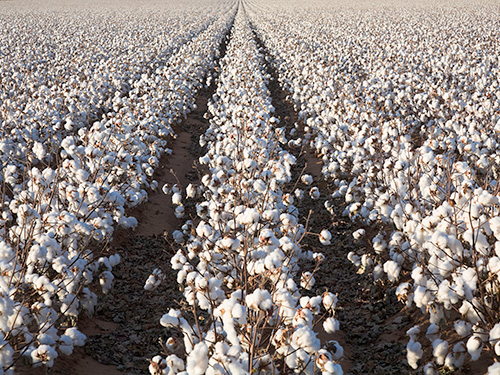West Tennessee Cotton Farmers Can Join National Study on Crop Threats Faced
Sep 22, 2025

Researchers at the University of Tennessee Institute of Agriculture are partnering with universities nationwide to study how these microscopic communities influence cotton growth and yield under different climates and farming practices.
Cotton crops face many threats, including drought, flooding, plant diseases such as cotton leaf crumple virus and cotton leafroll dwarf virus, and insect pests like whiteflies and aphids. While these issues may cause only minor damage on their own, they can have a greater impact when combined, weakening plants and disrupting the rhizosphere — the soil zone around roots where microbes live.
“Few studies have looked at the relationships between microorganisms, cotton varieties and farming practices such as cover crops,” said Avat Shekoofa, a UTIA crop physiology researcher. “This work is only possible through collaboration with universities across the country. The data we gather could help guide plant breeding, farm management and sustainable cotton production in many environments.”
To better understand these interactions, researchers are using advanced sequencing technology to study leaf and soil samples from diverse regions, including the Cotton Belt of West Tennessee. Each site offers distinct soils, climates and growing conditions.
Judith Brown, project lead and plant pathologist at the University of Arizona, said the research is needed as farmers face new pressures.
“Crop production is complex at both macro and micro levels,” she said. “As farmers continue to manage agronomic, economic and environmental challenges, reliable tools for assessing soil health are more important than ever.”
Randy Norton, an extension agronomist and cotton specialist with the University of Arizona, said the goal is to give growers more control over production.
“The more control we can give to farmers, the better their operations will be at every stage,” Norton said. “Stronger soil health directly supports yield and long-term sustainability.”
The project is led by the University of Arizona in partnership with UTIA, Texas A&M University and the University of California, with support from Cotton Incorporated. Early findings collected in 2025 will help form a proposal to the U.S. Department of Agriculture’s National Institute of Food and Agriculture for continued research.
The University of Tennessee Institute of Agriculture includes the Herbert College of Agriculture, UT College of Veterinary Medicine, UT AgResearch and UT Extension. Through its land-grant mission of teaching, research and outreach, the institute provides Real. Life. Solutions. for Tennesseans and beyond.
Learn more at utia.tennessee.edu.
Cotton crops face many threats, including drought, flooding, plant diseases such as cotton leaf crumple virus and cotton leafroll dwarf virus, and insect pests like whiteflies and aphids. While these issues may cause only minor damage on their own, they can have a greater impact when combined, weakening plants and disrupting the rhizosphere — the soil zone around roots where microbes live.
“Few studies have looked at the relationships between microorganisms, cotton varieties and farming practices such as cover crops,” said Avat Shekoofa, a UTIA crop physiology researcher. “This work is only possible through collaboration with universities across the country. The data we gather could help guide plant breeding, farm management and sustainable cotton production in many environments.”
To better understand these interactions, researchers are using advanced sequencing technology to study leaf and soil samples from diverse regions, including the Cotton Belt of West Tennessee. Each site offers distinct soils, climates and growing conditions.
Judith Brown, project lead and plant pathologist at the University of Arizona, said the research is needed as farmers face new pressures.
“Crop production is complex at both macro and micro levels,” she said. “As farmers continue to manage agronomic, economic and environmental challenges, reliable tools for assessing soil health are more important than ever.”
Randy Norton, an extension agronomist and cotton specialist with the University of Arizona, said the goal is to give growers more control over production.
“The more control we can give to farmers, the better their operations will be at every stage,” Norton said. “Stronger soil health directly supports yield and long-term sustainability.”
The project is led by the University of Arizona in partnership with UTIA, Texas A&M University and the University of California, with support from Cotton Incorporated. Early findings collected in 2025 will help form a proposal to the U.S. Department of Agriculture’s National Institute of Food and Agriculture for continued research.
The University of Tennessee Institute of Agriculture includes the Herbert College of Agriculture, UT College of Veterinary Medicine, UT AgResearch and UT Extension. Through its land-grant mission of teaching, research and outreach, the institute provides Real. Life. Solutions. for Tennesseans and beyond.
Learn more at utia.tennessee.edu.